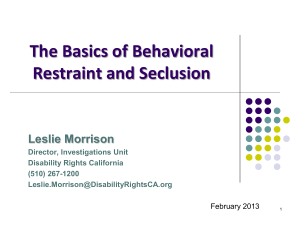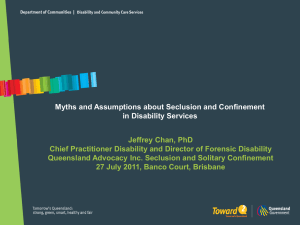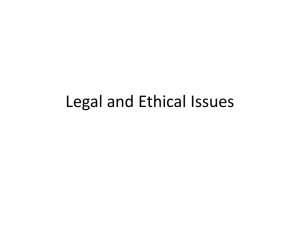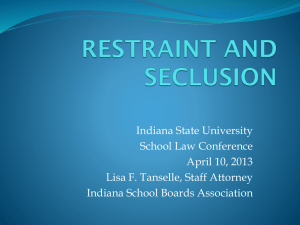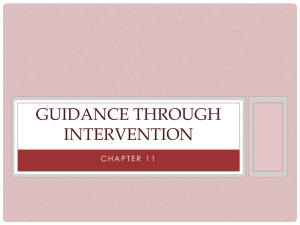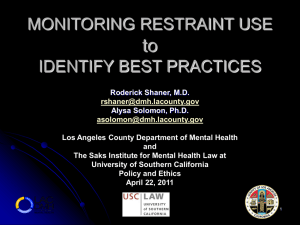JC Readiness Program Day 2
advertisement
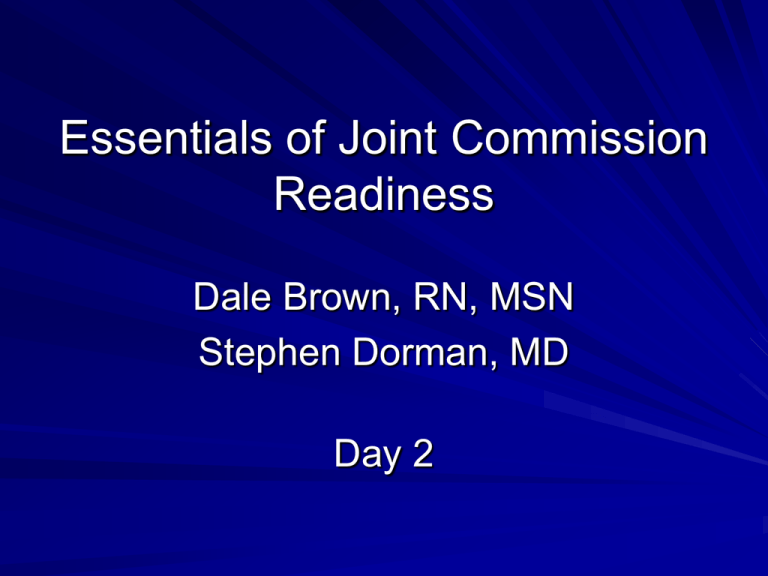
Essentials of Joint Commission Readiness Dale Brown, RN, MSN Stephen Dorman, MD Day 2 Patient Centered Communication PC. 02.01.21 The hospital effectively communicates with patients when providing care, treatment, and services. EP 1- (A)The hospital identifies the patients’ oral and written communication needs, including the patient’s preferred language for discussing health care. EP 2-(A) The hospital communicates with the patient during the provision of care, treatment, and services in a manner that meets the patient’s oral and written communication needs. 3 RI. 01.01.01 The hospital respects, protects, and promotes patient rights. EP # 5-(C) the hospital respects the patient’s right to and need for effective communication 4 RI. 01.01.03 The hospital respects the patient’s right to receive information in a manner he or she understands. EP# 2-The hospital provides language interpreting and translation services. (HR. 01.02.01, EP # 1) EP # 3-The hospital provides information to the patient who has vision, speech, hearing, or cognitive impairments in a manner that meets the patient’s needs. 5 Medication Management MM.01.01.03 The organization safely manages highalert and hazardous medications. 7 MM.01.01.03 5-A: The hospital reports abuses and losses of controlled substances to the individual responsible for the pharmacy department or service and to the chief executive officer, in accordance with law and regulation. 8 MM.03.01.01 The organization safely stores medications. Secure: no unsupervised, unauthorized individuals may access medications. 9 MM.03.01.01 3-A: The hospital stores controlled (scheduled) medications in a locked, secured area to prevent diversion, in accordance with law and regulation. Scheduled medications include those listed in Schedules II–V of the Comprehensive Drug Abuse Prevention and Control Act of 1970. 10 MM.03.01.01 19-A: The hospital has a pharmacy directed by a registered pharmacist or a supervised drug storage area, in accordance with law and regulation. 11 MM.05.01.07 The organization safely prepares medication. 12 MM.05.01.07 5-DI,A: Medications are prepared and administered in accordance with the orders of a licensed independent practitioner responsible for the patient's care, and in accordance with law and regulation. 13 MM.05.01.07 6-DI,A: In-house preparation of radiopharmaceuticals is done by, or under the direct supervision of, an appropriately trained registered pharmacist or doctor of medicine or osteopathy. Note: Direct defined by CMS as “on the same campus.” 14 MM.07.01.03 The organization responds to actual or potential adverse drug events, significant adverse drug reactions, and medication errors. 15 MM.07.01.03 6-DI,A: Medication administration errors, adverse drug reactions, and medication incompatibilities are immediately reported to the attending physician, and, as determined by the hospital, to the organization-wide performance improvement program. 16 CMS Changes for 2013 CMS Changes 1. Removal of requirement for special education for blood and medication administration. (HR.01.02.01) 2. Mandate for CEO, nurse leaders and medical staff leaders to address problems identified by infection control (LD.01.02.01). 3. A podiatrist may serve as a medical staff leader including president (LD.01.05.01). CMS Changes 4. Permission to use standing orders (without a requirement for an order) if: – Based on best practice guidelines – Approved by the medical staff, nursing and pharmacy – For a defined patient population – No “choices” in the set. – Maintain required to sign, date and time at some point. (MM.04.01.01) Restraint 5. Permission to use orders for care, treatment of services for outpatients from any licensed provider as allowed by laws and regulation providing there is a supporting hospital policy. (MM.05.01.07) 6. New reporting process for death in restraints. Not required for death in wrist restraints if the death is not related to the restraint. CMS Changes 7. All verbal orders must be authenticated within law and regulation. All time requirements have been removed but it is clear that unauthenticated orders at 30 days would constitute a delinquent record. 8. Authentications may be performed on behalf of partner physicians. CMS Changes 9: Single governing body 10. ONE medical staff per CCN. 11. Nursing care plans may be included in interdisciplinary care plans. 12. Removed requirement for one person responsible for ambulatory and outpatient care. Field Review Radiology Standards Stephen M. Dorman, M.D. 23 EC.02.01.01 The hospital manages safety and security risks. 24 EC.02.01.01 EP 14: For hospitals that provide magnetic resonance imaging (MRI) services: The hospital manages safety risks in the MRI environment associated with the following: - Patients who may experience claustrophobia, anxiety, or emotional distress 25 EC.02.01.01 EP 14: Patients who may require urgent or emergent medical care - Metallic implants and devices - Ferrous objects entering the MRI environment 26 EC.02.01.01 EP 16: For hospitals that provide magnetic resonance imaging (MRI) services: The hospital manages safety risks by doing the following: - Restricting access of everyone not trained screened by staff to an area that immediately precedes the entrance to the MRI scanner room 27 EC.02.01.01 EP 16: - Making sure that this area is controlled by and under the direct supervision MRI trained staff - Posting signage at the entrance to the MRI scanner room that conveys that the magnet is always on 28 EC.02.02.01 The hospital manages risks related to hazardous materials and waste. 29 EC.02.02.01 EP 17: For hospitals that provide computed tomography (CT), positron emission tomography (PET), or nuclear medicine (NM) services: The hospital monitors radiation exposure levels for all staff and licensed independent practitioners who routinely work in CT, PET, and NM areas. 30 EC.02.02.01 EP 17: Note: This is typically done through the use of exposure meters, such as personal dosimetry badges. 31 EC.02.04.01 The hospital manages medical equipment risks. 32 EC.02.04.01 EP 7: The hospital identifies activities and frequencies to maintain the image quality of the diagnostic images produced. The content and frequency of these activities are in accordance with state regulatory requirements, manufacturers’ guidelines, and the recommendations of a medical physicist. 33 EC.02.04.03 The hospital inspects, tests, and maintains medical equipment. 34 EC.02.04.03 EP 15: The hospital maintains the image quality of the diagnostic images produced. (See also EC.02.04.01, EP 7) 35 EC.02.04.03 EP 17: For hospitals that provide computed tomography (CT) services: When utilizing standard adult brain, adult abdomen, and pediatric brain protocols, a qualified medical physicist measures the actual radiation dose produced by each diagnostic CT imaging system at least annually and verifies that the radiation dose displayed on the system is within 20 percent of the actual amount of radiation dose delivered. The dates of these verifications are documented. 36 EC.02.04.03 Note: This element of performance is applicable only for systems capable of calculating and displaying radiation doses. 37 EC.02.04.03 EP 19: For hospitals that provide computed tomography (CT) services: If the hospital does not utilize standard adult brain, adult abdomen, or pediatric brain protocols, the hospital uses a qualified medical physicist to measure the actual radiation dose produced by each diagnostic CT imaging system at least annually and verify that the radiation dose displayed on the system is within 20 percent of the actual amount of radiation dose delivered for the three most common CT protocols used by the hospital. The dates of these verifications are documented. 38 EC.02.04.03 Note: This element of performance is applicable only for systems capable of calculating and displaying radiation doses 39 EC.02.04.03 EP 20: For hospitals that provide computed tomography (CT) services: At least annually, a medical physicist conducts a performance evaluation of all CT imaging equipment. The evaluation results, along with recommendations for correcting any problems identified, are documented. The evaluations include the use of phantoms to assess the following imaging metrics: 40 EC.02.04.03 EP 20: - Image uniformity - Slice thickness accuracy - Slice position accuracy - High-contrast resolution - Low-contrast resolution - Geometric or distance accuracy - CT number accuracy and uniformity - Artifact evaluation 41 EC.02.04.03 EP 21: For hospitals that provide magnetic resonance imaging (MRI) services: At least annually, a medical physicist or MRI scientist conducts a performance evaluation of all MRI imaging equipment. The evaluation results, along with recommendations for correcting any problems identified, are documented. The evaluations include the use of phantoms to assess the following imaging metrics: 42 EC.02.04.03 EP 21: - Image uniformity - Slice thickness accuracy - Slice position accuracy - High-contrast resolution - Low-contrast resolution (or contrast-to-noise ratio) - Geometric or distance accuracy - Magnetic field homogeneity (for MRI) - Artifact evaluation 43 EC.02.04.03 EP 22: For hospitals that provide positron emission tomography (PET) or nuclear medicine (NM) services: At least annually, a medical physicist conducts a performance evaluation of all imaging equipment. The evaluation results, along with recommendations for correcting any problems identified, are documented. The evaluations include the use of phantoms to assess the following imaging metrics: 44 EC.02.04.03 EP 22: - Image uniformity - Extrinsic or system uniformity - Intrinsic or system spatial resolution - Low-contrast resolution - Sensitivity - Energy resolution - Count-rate performance - Artifact evaluation 45 EC.02.06.05 The hospital manages its environment during demolition, renovation, or new construction to reduce risk to those in the organization. 46 EC.02.06.05 EP 4: For hospitals that provide computed tomography (CT), positron emission tomography (PET), or nuclear medicine (NM) services: The hospital conducts a shielding integrity survey of rooms where ionizing radiation will be emitted or radioactive materials will be used or stored (for example, scan rooms, injection rooms, hot lab). 47 EC.02.06.05 EP 4: Note: For additional guidance on structural shielding design, see National Council on Radiation Protection and Measurements Report No. 147 (NCRP-147). 48 HR.01.02.05 The hospital verifies staff qualifications. 49 HR.01.02.05 EP 19: For hospitals that provide computed tomography (CT) services: The hospital verifies and documents that a radiologic technologist who performs CT exams has the following qualifications: 50 HR.01.02.05 EP 19: - Registered by the American Registry of Radiologic Technologists (ARRT) - Certified by the ARRT in radiography and/or computed tomography - Trained and experienced in operating CT equipment 51 HR.01.02.05 EP 20: For hospitals that provide computed tomography (CT) services: Diagnostic medical physicists that support CT services are board certified in diagnostic radiological physics or radiological physics by the American Board of Radiology, the American Board of Medical Physics, or an equivalent source. If the diagnostic medical physicist is not board certified, then he or she has completed the following: 52 HR.01.02.05 EP 20: - A graduate degree in medical physics, radiologic physics, physics, or another relevant physical science or engineering discipline 53 HR.01.02.05 EP 20: - Formal coursework in the biological sciences with at least one course in biology or radiation biology, and one course in anatomy, physiology, or a similar topic related to the practice of medical physics - Three years of documented experience in a clinical CT environment 54 HR.01.05.03 Staff participate in ongoing education and training. 55 HR.01.05.03 EP 14: For hospitals that provide computed tomography (CT) services: The hospital verifies and documents that radiologic technologists who perform CT examinations participate in ongoing education. Ongoing education must include annual training on radiation dose reduction awareness and techniques following As Low As Reasonably Achievable (ALARA), Image Gently, and Image Wisely concepts. 56 HR.01.05.03 EP 25: Staff providing magnetic resonance imaging (MRI) services participate in education and training on safe practices in the MRI environment including the following: 57 HR.01.05.03 EP 25: - Patient screening criteria for ferrous-based items - Proper patient positioning activities to avoid burns - Equipment and supplies that have been determined to be safe for use in MRI areas - MRI safety response procedures for patients who require urgent or emergent medical care - MRI equipment emergency shutdown procedures 58 LD.04.04.01 (new standard) The hospital uses clinical practice guidelines when providing the following diagnostic imaging services: computed tomography, magnetic resonance imaging, positron emission tomography, and nuclear medicine. For Hospitals that use CT, MRI, PET and NM: 59 LD.04.04.01 EP 1: The hospital uses evidence-based guidelines and considers the patient’s age and previous imaging exams when deciding on the most appropriate type of imaging exam. 60 LD.04.04.01 EP 2: The hospital establishes imaging protocols based on current standards of practice, which address key criteria including, clinical indication, patient age, patient positioning, scan times, radiation dose limits, and contrast administration. See (PI.01.01.01, EP 46) 61 LD.04.04.01 EP 3: Imaging protocols are kept current and adjusted with input from an interpreting radiologist, medical physicist, and chief imaging technologist. Imaging protocols are adjusted based on individual patient needs and on changes to standards of practice. 62 MM.06.01.01 The hospital safely administers medications. 63 MM.06.01.01 EP 13: Before administering a radioactive isotope, staff verify that the dose to be administered is within 20% of the prescribed dose, or, if the dose is prescribed as a range, staff verify that the dose to be administered is within the prescribed range. 64 PC.01.02.15 The hospital provides for diagnostic testing. 65 PC.01.02.15 EP 5: The hospital documents in the patient’s record the radiation dose on every study produced during a CT examination. Note 1: This element of performance is applicable only for systems capable of calculating and displaying radiation doses. 66 PC.01.02.15 EP 5: Note 2: This element of performance does not apply to systems used for therapeutic radiation treatment planning or delivery, or for calculating attenuation coefficients for nuclear medicine studies. 67 PC.01.02.15 EP 6: For hospitals that provide computed tomography (CT) services: The interpretive report of a diagnostic CT study includes the radiation dose. The dose is either recorded in the patient's interpretive report or included on the protocol page, which is then attached to the interpretive report. (used to apply only to California). 68 PC.01.02.15 EP 7: For hospitals that provide computed tomography (CT) services: The hospital electronically sends each CT study and protocol page that lists the radiation dose and related technical factors to the hospital’s electronic picture archiving and communications system (PACS). 69 PC.01.02.15 EP 7: Note: This element of performance is only applicable for systems capable of calculating and displaying radiation doses. 70 PC.01.02.15 EP 10: For hospitals that provide computed tomography (CT), magnetic resonance imaging (MRI), positron emission tomography (PET), or nuclear medicine (NM) services: Prior to conducting a diagnostic imaging study, the hospital verifies the following: 71 PC.01.02.15 EP 10: Correct patient - Correct imaging site - Correct patient positioning - For CT only: Correct imaging protocol - For CT only: Correct scanner parameters 72 PC.01.02.15 EP 11: For hospitals that provide computed tomography (CT), magnetic resonance imaging (MRI), positron emission tomography (PET), or nuclear medicine (NM) services: The hospital makes certain that imaging studies are based on an order from a licensed independent practitioner or other qualified practitioner in accordance with law and regulation. 73 PI.01.01.01 The hospital collects data to monitor its performance. 74 PI.01.01.01 EP 46: For hospitals that provide computed tomography (CT) services: The hospital collects data on incidents where radiation dose limits identified in imaging protocols have been exceeded. 75 PI.01.01.01 EP 47: For hospitals that provide magnetic resonance imaging (MRI) services: The hospital collects data on patient burns that occur during MRI exams. 76 PI.01.01.01 EP 48: For hospitals that provide magnetic resonance imaging (MRI) services: The hospital collects data on the following: - Incidents when ferrous-based items entered the MRI scanner room - Injuries resulting from the presence of ferrous-based items in the MRI scanner room 77 PI.02.01.01 The hospital compiles and analyzes data. 78 PI.02.01.01 EP 6: For hospitals that provide computed tomography (CT) services: The hospital analyzes data on CT radiation doses and compares it with external benchmarks, when available. 79 Medical Staff OPPE and FPPE The Joint Commission’s New Approach to Assessing Physician Performance The Standard: MS.05.01.01: CLINICAL The organized medical staff has a leadership role in organization performance improvement activities to improve quality of care, treatment, and services and [patient] safety. Relevant information developed from the following processes is integrated into performance improvement initiatives and consistent with [organization] preservation of confidentiality and privilege of information. 81 The Standard: MS.05.01.01 1: The organized medical staff provides leadership for measuring, assessing, and improving processes that primarily depend on the activities of one or more licensed independent practitioners, and other practitioners credentialed and privileged through the medical staff process. (See also PI.03.01.01, EPs 1-4) 82 The Standard: MS.05.01.01 2: The medical staff is actively involved in the measurement, assessment, and improvement of the following: Medical assessment and treatment of patients. (See also PI.03.01.01, EPs 1-4) 83 The Standard: MS.05.01.01 3: The medical staff is actively involved in the measurement, assessment, and improvement of the following: Use of information about adverse privileging decisions for any practitioner privileged through the medical staff process. 84 The Standard: MS.05.01.01 4: The medical staff is actively involved in the measurement, assessment, and improvement of the following: Use of medications 85 The Standard: MS.05.01.01 5: The medical staff is actively involved in the measurement, assessment, and improvement of the following: Use of blood and blood components 86 The Standard: MS.05.01.01 6: The medical staff is actively involved in the measurement, assessment, and improvement of the following: Operative and other procedure(s) – Judgment (decision making) – Clinical and Technical Skills 87 The Standard: MS.05.01.01 7: The medical staff is actively involved in the measurement, assessment, and improvement of the following: Appropriateness of clinical practice patterns. – Utilization Review (LOS, Avoidable days, denials) 88 The Standard: MS.05.01.01 8: The medical staff is actively involved in the measurement, assessment, and improvement of the following: Significant departures from established patterns of clinical practice. – All other departments: Pathology, radiology, anesthesiology, ER 89 The Standard: MS.05.01.01 9: The medical staff is actively involved in the measurement, assessment, and improvement of the following: The use of developed criteria for autopsies. (CMS REQUIREMENT) 90 The Standard: MS.05.01.01 10: Information used as part of the performance improvement mechanisms, measurement, or assessment includes the following: Sentinel event data. 91 The Standard: MS.05.01.01 11: Information used as part of the performance improvement mechanisms, measurement, or assessment includes the following: Patient safety data. 92 The Standard: MS.05.01.03: CITIZENSHIP 1: The organized medical staff participates in the following activities: Education of patients and families. 93 The Standard: MS.05.01.03: CITIZENSHIP 2: The organized medical staff participates in the following activities: Coordination of care, treatment, and services with other practitioners and hospital personnel, as relevant to the care, treatment, and services of an individual patient. 94 The Standard: MS.05.01.03: CITIZENSHIP 3: The organized medical staff participates in the following activities: Accurate, timely, and legible completion of patient’s medical records. 95 The Standard: MS.05.01.03: CITIZENSHIP 4: The organized medical staff participates in the following activities: Review of findings of the assessment process that are relevant to an individual’s performance. The organized medical staff is responsible for determining the use of this information in the ongoing evaluations of a practitioner’s competence. 96 The Standard: MS.05.01.03: CITIZENSHIP 5: The organized medical staff participates in the following activities: Communication of findings, conclusions, recommendations, and actions to improve performance to appropriate staff members and the governing body. 97 The Standard: MS.08.01.03 Ongoing professional practice evaluation information is factored into the decision to maintain existing privilege(s), to revise existing privilege(s), or to revoke an existing privilege prior to or at the time of renewal. 98 The Standard: MS.08.01.03 1: The process for the ongoing professional practice evaluation includes the following: There is a clearly defined process in place that facilitates the evaluation of each practitioner’s professional practice. (D means there must be a policy) 99 The Standard: MS.08.01.03 2: The process for the ongoing professional practice evaluation includes the following: The type of data to be collected is determined by individual departments and approved by the organized medical staff. (Performance measures must be defined for CMS in a Medical Staff Plan). 100 The Standard: MS.08.01.03 3: The process for the ongoing professional practice evaluation includes the following: Information resulting from the ongoing professional practice evaluation is used to determine whether to continue, limit, or revoke any existing privilege(s). 101 FOCUSED REVIEW While it was a good thing to evaluate providers after they had already been working 6 months, it was apparent that there was real risk in the “unknown”. Peer Recommendations could not be trusted. Harm could come to patients soon after practice began. 102 FOCUSED REVIEW There were analogous standards in the Human Resources chapter for an “initial assessment of competency” before hospital staff could carry out job responsibilities independently. 103 FOCUSED REVIEW It was clear that something was needed on the “front end.” Next it was determined that in classic “peer review”, cases simply fell off and issues were never closed or casually investigated. There was no accountability for closure of many significant issues. 104 FOCUSED REVIEW The purpose: – Initial assessment competence of all new physicians or new privileges regardless of experience. – Conduct intensive, planned and “focused” investigations when adverse events occurred (trigger events). – Conduct intensive, planned and “focused” investigations when ongoing performance measurement indicated undesirable performance. 105 Focused Review: New Privileges Goal: To be conducted as rapidly as possible. “Volume” of review defined by the medical staff and departments. Individual plans should be developed to allow the medical staff to know when the review has concluded. Each provider may warrant a tailored plan. Some departments are completely uniform. 106 Focused Review: New Privileges Should be conducted in a time frame that is too short for rate based performance measurement: data collection would not be statistically significant for short term. Evaluation of privilege must be realistic: chart review versus direct observation. All requirements defined in a plan. TOP Medical Staff Standard RFI in 2009. 107 The Standard: MS.08.01.01 The organized medical staff defines the circumstances requiring monitoring and evaluation of a practitioner’s professional performance. - Initial Appointment (new privileges) - New mid-cycle privilege - Trigger events - Variant data 108 The Standard: MS.08.01.01 The focused evaluation process is defined by the organized medical staff. The time period of the evaluation can be extended, and/or a different type of evaluation process assigned. Information for focused professional practice evaluation may include chart review, monitoring clinical practice patterns, simulation, proctoring, external peer review, and discussion with other individuals involved in the care of each patient (e.g., consulting physicians, assistants at surgery, nursing or administrative personnel). 109 The Standard: MS.08.01.01 Relevant information resulting from the focused evaluation process is integrated into performance improvement activities, consistent with the organization’s policies and procedures that are intended to preserve confidentiality and privilege of information. 110 The Standard: MS.08.01.01 1: A period of focused professional practice evaluation is implemented for all initially requested privileges. 111 The Standard: MS.08.01.01 2: The organized medical staff develops criteria to be used for evaluating the performance of practitioners when issues affecting the provision of safe, high quality patient care are identified. (D means Plan) 112 The Standard: MS.08.01.01 3: The performance monitoring process is clearly defined and includes each of the following elements: - Criteria for conducting performance monitoring - Method for establishing a monitoring plan specific to the requested privilege - Method for determining the duration of performance monitoring - Circumstances under which monitoring by an external source is required 113 The Standard: MS.08.01.01 4: Focused professional practice evaluation is consistently implemented in accordance with the criteria and requirements defined by the organized medical staff. 114 The Standard: MS.08.01.01 5: The triggers that indicate the need for performance monitoring are clearly defined. Note: Triggers can be single incidents or evidence of a clinical practice trend. 115 The Standard: MS.08.01.01 6: The decision to assign a period of performance monitoring to further assess current competence is based on the evaluation of a practitioner’s current clinical competence, practice behavior, and ability to perform the requested privilege. Note: Other existing privileges in good standing should not be affected by this decision. 116 The Standard: MS.08.01.01 7: Criteria are developed that determine the type of monitoring to be conducted. (D means this has to be in the plan). 117 The Standard: MS.08.01.01 8: The measures employed to resolve performance issues are clearly defined. (D means it must be in the plan). 118 The Standard: MS.08.01.01 9: The measures employed to resolve performance issues are consistently implemented. 119 Scoring All of the medical staff standards on these issues are “A” meaning 100% compliance is required Focused Review: 16% of hospitals cited Ongoing Review: 15% of hospitals cited Problems with no or low volume providers Changes to privileges based on data 120 Restraints PC.03.05.03 The organization uses restraint or seclusion safely. 122 PC. 03.05.03 Elements of Performance 1-DI, A: The hospital implements restraint or seclusion using safe techniques identified by the hospital’s policies and procedures in accordance with law and regulation. 2-M, C: The use of restraint and seclusion is in accordance with a written modification to the patient's plan of care. 123 PC. 03.05.05 The organization initiates restraint or seclusion based on an individual order. 124 PC. 03.05.05 Elements of Performance 3-A: The attending physician is consulted as soon as possible (immediately), in accordance with hospital policy, if he or she did not order the restraint or seclusion. 125 PC. 03.05.05 4-M, C: Unless state law is more restrictive, orders for the use of restraint or seclusion used for the management of violent or self-destructive behavior that jeopardizes the immediate physical safety of the patient, staff, or others may be renewed within the following limits: • 4 hours for adults 18 years of age or older • 2 hours for children and adolescents 9 to 17 years of age • 1 hour for children under 9 years of age 126 PC. 03. 05. 05 Elements of Performance 5-DI, A: Unless state law is more restrictive, every 24 hours, a physician or other authorized licensed independent practitioner primarily responsible for the patient’s ongoing care sees and evaluates the patient before writing a new order for restraint or seclusion used for the management of violent or self-destructive behavior that jeopardizes the immediate physical safety of the patient, staff, or others in accordance with hospital policy and law and regulation. 127 PC. 03.05.05 Elements of Performance 6-DI, A: Orders for restraint used to protect the physical safety of the nonviolent or non-self-destructive patient are renewed in accordance with hospital policy. 128 PC. 03.05.07 The organization monitors patients who are restrained or secluded. 129 PC. 03.05.07 1-DI, A: Physicians or other licensed independent practitioners or staff who have been trained in accordance with 42 CFR 482.13(f) monitor the condition of patients in restraint or seclusion. (See PC.03.05.17, EP 3) 130 PC. 03.05.09 The organization has written policies and procedures that guide the use of restraint or seclusion. 131 PC. 03.05.09 Elements of Performance 1-D, A: The hospital’s policies and procedures regarding restraint or seclusion include the following: • Physician and other authorized licensed independent practitioner training requirements • Staff training requirements • The determination of who has authority to order restraint and seclusion 132 PC. 03.05.09 Elements of Performance 1-D, A: The hospital’s policies and procedures regarding restraint or seclusion include the following The determination of who has authority to discontinue the use of restraint or seclusion The determination of who can initiate restraint or seclusion The circumstances under which restraint or seclusion is discontinued. The requirement that restraint or seclusion is discontinued as soon as is safely possible 133 PC. 03.05.09 Elements of Performance The hospital’s policies and procedures regarding restraint or seclusion include the following: • A definition of restraint in accordance with 42 CFR 482.13(e)(1)(i)(A-C) • A definition of seclusion in accordance with 42 CFR 482.13(e)(1)(ii) • A definition or description of what constitutes the use of medications as a restraint in accordance with 42 CFR 482.13(e)(1)(i)(B) 134 PC. 03.05.09 Elements of Performance The hospital’s policies and procedures regarding restraint or seclusion include the following: • A determination of who can assess and monitor patients in restraint or seclusion • Time frames for assessing and monitoring patients in restraint or seclusion 135 PC. 03.05.09 Elements of Performance 2-DI,A: Physicians and other licensed independent practitioners authorized to order restraint or seclusion (through hospital policy in accordance with law and regulation) have a working knowledge of the hospital policy regarding the use of restraint and seclusion. 136 PC. 03.05.11 The organization evaluates and reevaluates the patient who is restrained or secluded. 137 PC. 03.05.11 Elements of Performance 1-D, A: A physician or other licensed independent practitioner responsible for the care of the patient evaluates the patient in-person within one hour of the initiation of restraint or seclusion used for the management of violent or self-destructive behavior that jeopardizes the physical safety of the patient, staff, or others. A registered nurse or a physician assistant may conduct the in-person evaluation within one hour of the initiation of restraint or seclusion; this individual is trained in accordance with the requirements at PC.03.05.17, EP 3. 138 PC. 03.05.11 Elements of Performance 2-DI, A: When the in-person evaluation (performed within one hour of the initiation of restraint or seclusion) is done by a trained registered nurse or trained physician assistant, he or she consults with the attending physician or other licensed independent practitioner responsible for the care of the patient as soon as possible after the evaluation, as determined by hospital policy. 139 PC. 03.05.11 Elements of Performance 3-DI, A: The in-person evaluation, conducted within one hour of the initiation of restraint or seclusion for the management of violent or self-destructive behavior that jeopardizes the physical safety of the patient staff or others, includes the following: • An evaluation of the patient's immediate situation • The patient's reaction to the intervention • The patient's medical and behavioral condition • The need to continue or terminate the restraint or seclusion 140 PC.03.05.13 The organization continually monitors patients who are simultaneously restrained and secluded. 141 PC. 03.05.13 1-DI, A: The patient who is simultaneously restrained and secluded is continually monitored by trained staff either in-person or through the use of both video and audio equipment that is in close proximity to the patient. 142 PC. 03.05.15 The organization documents the use of restraint or seclusion. 143 PC. 03.05.15 Elements of Performance 1-M, C: Documentation of restraint and seclusion in the medical record includes the following: • Any in-person medical and behavioral evaluation for restraint or seclusion used to manage violent or self-destructive behavior • A description of the patient’s behavior and the intervention used • Any alternatives or other less restrictive interventions attempted 144 PC. 03.05.15 Elements of Performance 1-M, C: Documentation of restraint and seclusion in the medical record includes the following: • The patient’s condition or symptom(s) that warranted the use of the restraint or seclusion • The patient’s response to the intervention(s) used, including the rationale for use of the intervention • Individual patient assessments and reassessments • The intervals for monitoring 145 PC. 03.05.15 Elements of Performance 1-M,C: Documentation of restraint and seclusion in the medical record includes the following: • • • Revisions to the plan of care The patient’s behavior and staff concerns regarding safety risks to the patient, staff, and others that necessitated the use of restraint or seclusion Injuries to the patient 146 PC. 03.05.15 Elements of Performance 1-M, C: Documentation of restraint and seclusion in the medical record includes the following: • • • • • Death associated with the use of restraint or seclusion The identity of the physician or other licensed independent practitioner who ordered the restraint or seclusion Orders for restraint or seclusion Notification of the use of restraint or seclusion to the attending physician Consultations 147 PC. 03.05.17 The organization trains staff to safely implement the use of restraint or seclusion. 148 PC. 03.05.17 Elements of Performance 2-M, C: The hospital trains staff on the use of restraint and seclusion, and assesses their competence, at the following intervals: • At orientation • Before participating in the use of restraint and seclusion • On a periodic basis thereafter 149 PC. 03.05.17 Elements of Performance 3-M, C: Based on the population served, staff education, training, and demonstrated knowledge focus on the following: • Safe application and use of all types of restraint or seclusion used in the hospital, including training in how to recognize and respond to signs of physical and psychological distress (for example, positional asphyxia) • Clinical identification of specific behavioral changes that indicate that restraint or seclusion is no longer necessary 150 PC. 03.05.17 Elements of Performance 3-M, C: Based on the population served, staff education, training, and demonstrated knowledge focus on the following: • Monitoring the physical and psychological wellbeing of the patient who is restrained or secluded, including but not limited to respiratory and circulatory status, skin integrity, vital signs, and any special requirements specified by hospital policy associated with the in-person evaluation conducted within one hour of initiation of restraint or seclusion 151 PC. 03.05.17 Elements of Performance 3-M, C: Based on the population served, staff education, training, and demonstrated knowledge focus on the following: • Use of first aid techniques and certification in the use of cardiopulmonary resuscitation, including required periodic recertification 152 PC. 03.05.17 Elements of Performance 4-A: Individuals providing staff training in restraint or seclusion have education, training, and experience in the techniques used to address patient behaviors that necessitate the use of restraint or seclusion. 153 PC.03.05.17 Elements of Performance 5-M, D, C: The hospital documents in staff records that restraint and seclusion training and demonstration of competence were completed. 154 CMS Restraint Changes 155 Reporting Restraint-Related Deaths Restraint-Related Deaths: Replaces the requirement that hospitals report deaths related to soft, 2- point restraints, with a requirement that hospitals maintain a log (or other system) that will be made available to CMS if requested. 156 Reporting Restraint-Related Deaths Log: The Log is internal to the hospital and the name of the practitioner responsible for the care of the patient may be used in the log in lieu of the name of the attending physician if the patient was under the care of a non-MD practitioner. 157 Reporting Restraint Deaths Section 482.13 is amended by a) revising paragraphs (g)(1) through (3) and b) adding paragraph (g)(4). The revisions and addition read as follows: With the exception of deaths described under paragraph (g)(2) of this section the hospital must report the following information to CMS by telephone, fax or electronically as determined by CMs no later than the close of next business day 158 CMS Restraint Changes (g) (i) Each death that occurs while a patient is in restraint or seclusion (g) (ii) Each death that occurs within 24 hours after that patient has been removed from restrain or seclusion 159 Reporting Restraint-Related Deaths (g) (iii) Each death known to the hospital that occurs within 1 week after restraint or seclusion where it is reasonable to assume that use of restraint or placement in seclusion contributed directly or indirectly to the patient’s death, regardless of the type (s) of restraint used on the patient during this time. 160 Reporting Restraint-Related Deaths (2) When no seclusion has been used and when the only restraints used on the patient tare those applied exclusively to the patient’s wrist(s), and which are composed solely of soft, non-rigid, clothlike materials, the hospital staff must record in an internal log or other system, the following information: 161 Internal Restraint Log Components (i) Any death that occurs while a patient is in restraints (ii) Any death that occurs within 24 hours after a patient has been removed from such restraints. 162 Internal Restraint Log Components (3) The staff must document in the patient’s medical record the date and time the death was: – Reported to CMS for deaths described in (g) (1) of this section or other systems for deaths described in paragraph (g) (2) of this section. For deaths described in paragraph (g) 2 of this section entries into the internal log or other system must be documented as follows: 163 Internal Restraint Log Components (ii) The information must be made available in either written or electronic form to CMS immediately upon request. 164 Internal Restraint Log Components (i) Each entry must be made not later than 7 days after the date of death of the patient. (ii) Each entry must document the patient’s name, date of birth , date of death, name of attending physician or other LIP who is responsible for the care of the patient , medical record number and primary diagnosis(es) 165 Patient Flow Standards LD 04.03.11 The hospital manages the flow of patients throughout the hospital. LD.04.03.11 EP # 1 – The hospital has processes that support the flow of patients throughout the hospital. EP # 2 – The hospital plans for the care of admitted patients who are in temporary bed locations, such as the post-anesthesia care unit or the emergency department. EP # 3 – The hospital plans for care to patients placed in overflow locations. LD. 04.03. 11 EP # 4 – Criteria guide decisions to initiate ambulance diversion. EP # 5 – The hospital measures and sets goals the components of the patient flow process including: The available supply of beds The throughput of areas where patients receive care, treatment, and services ( such as inpatient units, laboratory, operating rooms, telemetry, radiology and PACU. LD. 04.03.11 EP. # 5 (Continued) – The safety of areas where patients receive care, treatment and services – The efficiency of the non-clinical services that support patient care and treatment (such as housekeeping and transportation). – Access to support services (such as case management and social work) LD. 04.03.11 EP # 6 – Effective January 1, 2014 – The hospital measures and sets goals for mitigating and managing the boarding of patients who come through the emergency department. – Note: Boarding is the practice of holding patients in the emergency department or a temporary location after the decision to admit or transfer has been made. The hospital should set its goals with attention to patient acuity and best practice; it is recommended that boarding timeframes not exceed 4 hours in the interest of patient safety and quality of care. LD. 04.03.011 EP # 6 (Cross-referenced standard) – NPSG. 15.01.01., EP’s 1 & 2, PC.01.01.01 EP’s 4 & 9 PC. 01.02.03, EP 3, PC. 02.01.19, EP 1 & 2 NPSG. 15.01.01 EP # 1 Conduct a risk assessment that identifies specific patient characteristics and environmental features that may increase or decrease the risk for suicide. LD. 04.03.11 NPSG. 15.01.01. EP # 2 Address the patient’s immediate safety needs and most appropriate setting for treatment. PC.01.01.01 The hospital accepts the patient in the care, treatment, and services based on its ability to meet the patient’s needs. LD. 04.03.11 PC. 01.01.01 EP # 4 Hospitals that do not primarily provide psychiatric or substance abuse services have a written plan that defines the care, treatment and services or the referral process for patients who are emotionally ill or suffer the effects of alcoholism or substance abuse LD. 04.03.11 PC. 01. 01. 01 EP # 24 If a patient is boarded while awaiting for emotional illness and/or the effects of alcoholism or substance abuse, the hospital does the following: – Provides for a location for the patient that is safe, monitored, and clear of items that the patient could use to harm himself or herself or others. – Provides orientation and training to any clinical and non-clinical staff caring for such patients in effective and safe care, treatment, and services. – Conducts assessments, and reassessments, and provides care consistent with the patients’ identified needs. LD. 04.03.11 PC. 01.02.03 EP # 3 Each patient is reassessed as necessary based on his or her plan for care or changes in his or her condition. Note: Reassessments may also be based on the patient's diagnosis; desire for care, treatment, and services; response to previous care, treatment, and services; and/or his or her setting requirements. LD.04.03.11 PC. 02.01.19 EP # 1 The hospital has a process for recognizing and responding as soon as a patient’s condition appears to be worsening. PC. 02.01.19 EP # 2 The hospital develops written criteria describing early warning signs of a change or deterioration in a patient’s condition and when to seek further assistance. LD. 04.03.11 EP # 7 The individuals who manage patient flow processes review measurement results to determine that goals were achieved. Cross-referenced standard NR. 02.02.01 EP # 4 The nurse executive, registered nurses, and other designated nursing staff write: Nursing standards of patient care, treatment, and services. LD. 04.03.11 EP # 8 Leaders take action when patient flow goals are not achieved. Cross-referenced standard PI. 03.01.01, EP #4 The hospital takes action when it does not achieve or sustain planned improvements. LD. 04.03.11 Note for EP # 8. At a minimum, leaders included medical staff and governing body, the chief executive officer and other senior managers, the chief nurse executive, clinical leaders, staff members in leadership positions within the organization. LD. 04.03.11 EP # 9 Effective January 1, 2014 When the hospital determines that it has a population at risk for boarding due to behavioral health emergencies, hospital leaders communicate with behavioral health providers and/or authorities serving the community to foster coordination of care for this population Cross-referenced standards LD. 03.04.01 EP’s #3 &6 LD. 04.03.11 LD. 03. 04. 01 EP # 3 Communication is designed to meet the needs of internal and external users. EP # 6 When changes in the environment occur, the hospital communicates those changes effectively Leadership LD.04.03.09 Care, treatment, and services provided through contractual agreement are provided safely and effectively. 184 LD.04.03.09 1-A: Clinical leaders and medical staff have an opportunity to provide advice about the sources of clinical services to be provided through contractual agreement. 2-D,A: The hospital describes, in writing, the nature and scope of services provided through contractual agreements. 185 LD.04.03.09 3-D,A: Designated leaders approve contractual agreements. 186 LD.04.03.09 4-A: Leaders monitor contracted services by establishing expectations for the performance of the contracted services. 5-D,A:Leaders monitor contracted services by communicating the expectations in writing to the provider of the contracted services. Note: A written description of the expectations can be provided either as part of the written agreement or in addition to it. 187 LD.04.03.09 6-A: Leaders monitor contracted services by evaluating these services in relation to the hospital's expectations 188 LD.04.03.09 7-A: Leaders take steps to improve contracted services that do not meet expectations. Note: Examples of improvement efforts to consider include the following: - Increase monitoring of the contracted services. - Provide consultation or training to the contractor. - Renegotiate the contract terms. - Apply defined penalties. - Terminate the contract. 189 LD.04.03.09 8-DI,A: When contractual agreements are renegotiated or terminated, the hospital maintains the continuity of patient care. 10-D,A: Reference and contract laboratory services meet the federal regulations for clinical laboratories and maintain evidence of the same. 190 Contract Principles TJC does not require organizations to manually verify each contract employee file. If the contracting entity is Joint Commission accredited there is no requirement to request the information on the employee Full hospital orientation is not required Orientation to key areas such as emergency preparedness, infection control, safety, and security is critical. 191 Contract Principles If specified in the contract, the contracting organization can rely on the contract staff provider to complete annual in-service training, many topics of which are the same as those required by the customer (such as, infection control, populationspecific health care, cultural diversity, proper lifting techniques, and so forth). 192 Contract Principles Contracts must be in writing. The organization must define the expectations of the contract, including human resource expectation. The contract should specify that the contracted organization will provide only staff who are qualified in relation to their education, training, licensure, and competence as defined by the contracting organization. 193 Contract Principles The contracted organization has the responsibility to verify orientation, performance evaluations, health status, background checks, and any applicable references. 194 Contract Principles The contract should include the following: Define within the contract the required qualifications for the contracted staff Review the personnel practices of the contracted organization to assess compliance with its own and Joint Commission requirements (for example, who will complete competence assessments) 195 Contract Principles If the contracted organization’s practices are acceptable, the organization can accept those practices for the provided contracted personnel. If the contracted organization’s practices are not acceptable, the organization can define in the contract the specific requirements or perform the requirements itself. 196 Human Resources Competence Assessment Activity Competence Assessment 10-12 Personnel Records Contract Personnel based on list provided Agency Staff Bring Hospital Orientation curriculum Education Requirements (see handout) Make sure department manager of requested employee is present for the activity. 198 2013 Education Requirements Arranged by Chapter in Joint Commission Manual Annually means every 12 months, different than yearly Ongoing is surveyed as every 3 years or so At orientation-is before being independent 199 HR.01.02.01 The hospital defines staff qualifications Job Descriptions 200 HR. 01.02.05 7-DI, A: Before providing care, treatment, and services, the hospital confirms that non-employees who are brought into the hospital by a licensed independent practitioner to provide care, treatment, or services have the same qualifications and competencies required of employed individuals performing the same or similar services at the hospital. 201 Human Resources Non-advanced practice employees of physicians – Equivalent process, orientation safety, department, primary source verification – Initial competency determined – Annual competence determined Physician employed advance practice personnel ( CRNA, CNM, PA, ARNP) 202 HR.01.04.01 The hospital provides orientation to staff. 203 HR.01.04.01 3-A: The hospital orients staff on the following: Relevant hospital-wide and unit-specific policies and procedures. Completion of this orientation is documented. 204 HR. 01.04.01 7-M,C:The hospital orients external law enforcement and security personnel on the following: – How to interact with patients – Procedures for responding to unusual clinical events and incidents – The hospital’s channels of clinical, security, and administrative communication – Distinctions between administrative and clinical seclusion and restraint 205 Problematic Human Resources Standards HR. 01.06.01 Staff Competence Positions of one--An individual with the educational background, experience, or knowledge related to the skills being reviewed assesses competence. Performance evaluations (HR. 01.07.01) Frequency/Measurement/Delinquency (C) 206 Frequently Cited Standards 207 Frequently Cited Standards RC.01.01.01: 55% – Dating, timing LS.02.01.20: 54% – Means of egress, hall clutter IC.02.02.01: 47% – Instrument processing, sterilization, high level disinfection 208 Frequently Cited Standards EC.02.05.01: 46% – Air pressure differentials LS.02.01.01: 45% – Fire ratings of walls and penetrations EC.02.03.05: 40% – Fire safety equipment and fire safety features LS.02.01.30: 39% – Protection of hazardous areas 209 Frequently Cited Standards EC.02.06.01: 35% – Humidity 35-60% or get waiver 20-60% MM.03.01.01: 35% – Medication Security, controlled substances – Vaccine storage LS.02.01.35: 34% – Sprinklers and Fire Extinguishers 210 QUESTIONS?? 211 212


